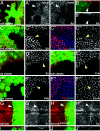The apical-basal cell polarity determinant Crumbs regulates Hippo signaling in Drosophila
- PMID: 20798049
- PMCID: PMC2936591
- DOI: 10.1073/pnas.1004060107
The apical-basal cell polarity determinant Crumbs regulates Hippo signaling in Drosophila
Abstract
Defects in apical-basal cell polarity and abnormal expression of cell polarity determinants are often associated with cancer in vertebrates. In Drosophila, abnormal expression of apical-basal determinants can cause neoplastic phenotypes, including loss of cell polarity and overproliferation. However, the pathways through which apical-basal polarity determinants affect growth are poorly understood. Here, we investigated the mechanism by which the apical determinant Crumbs (Crb) affects growth in Drosophila imaginal discs. Overexpression of Crb causes severe overproliferation, and we found that loss of Crb similarly results in overgrowth of imaginal discs. Crb gain and loss of function caused defects in Hippo signaling, a key signaling pathway that controls tissue growth in Drosophila and mammals. Manipulation of Crb levels caused the up-regulation of Hippo target genes, genetically interacted with known Hippo pathway components, and required Yorkie, a transcriptional coactivator that acts downstream in the Hippo pathway, for target gene induction and overgrowth. Interestingly, Crb regulates growth and cell polarity through different motifs in its intracellular domain. A juxtamembrane FERM domain-binding motif is responsible for growth regulation and induction of Hippo target gene expression, whereas Crb uses a PDZ-binding motif to form a complex with other polarity factors. The Hippo pathway component Expanded, an apically localized adaptor protein, is mislocalized in both crb mutant cells and Crb overexpressing tissues, whereas the other Hippo pathway components, Fat and Merlin, are unaffected. Taken together, our data show that Crb regulates growth through Hippo signaling, and thus identify Crb as a previously undescribed upstream input into the Hippo pathway.
Conflict of interest statement
The authors declare no conflict of interest.
Figures





Similar articles
-
The apical transmembrane protein Crumbs functions as a tumor suppressor that regulates Hippo signaling by binding to Expanded.Proc Natl Acad Sci U S A. 2010 Jun 8;107(23):10532-7. doi: 10.1073/pnas.1004279107. Epub 2010 May 24. Proc Natl Acad Sci U S A. 2010. PMID: 20498073 Free PMC article.
-
Crumbs regulates Salvador/Warts/Hippo signaling in Drosophila via the FERM-domain protein Expanded.Curr Biol. 2010 Apr 13;20(7):582-90. doi: 10.1016/j.cub.2010.03.019. Epub 2010 Apr 1. Curr Biol. 2010. PMID: 20362445 Free PMC article.
-
The Hippo tumor-suppressor pathway regulates apical-domain size in parallel to tissue growth.J Cell Sci. 2009 Jul 15;122(Pt 14):2351-9. doi: 10.1242/jcs.046482. Epub 2009 Jun 16. J Cell Sci. 2009. PMID: 19531584 Free PMC article.
-
Lgl/aPKC and Crb regulate the Salvador/Warts/Hippo pathway.Fly (Austin). 2010 Oct-Dec;4(4):288-93. doi: 10.4161/fly.4.4.13116. Epub 2010 Oct 21. Fly (Austin). 2010. PMID: 20798605 Free PMC article. Review.
-
The Hippo pathway and apico-basal cell polarity.Biochem J. 2011 Jun 1;436(2):213-24. doi: 10.1042/BJ20110217. Biochem J. 2011. PMID: 21568941 Review.
Cited by
-
Bazooka/PAR3 is dispensable for polarity in Drosophila follicular epithelial cells.Biol Open. 2015 Mar 13;4(4):528-41. doi: 10.1242/bio.201410934. Biol Open. 2015. PMID: 25770183 Free PMC article.
-
The Drosophila ortholog of MLL3 and MLL4, trithorax related, functions as a negative regulator of tissue growth.Mol Cell Biol. 2013 May;33(9):1702-10. doi: 10.1128/MCB.01585-12. Epub 2013 Mar 4. Mol Cell Biol. 2013. PMID: 23459941 Free PMC article.
-
Expression of polarity genes in human cancer.Cancer Inform. 2015 Mar 30;14(Suppl 3):15-28. doi: 10.4137/CIN.S18964. eCollection 2015. Cancer Inform. 2015. PMID: 25991909 Free PMC article.
-
YAP1 recruits c-Abl to protect angiomotin-like 1 from Nedd4-mediated degradation.PLoS One. 2012;7(4):e35735. doi: 10.1371/journal.pone.0035735. Epub 2012 Apr 27. PLoS One. 2012. PMID: 22558212 Free PMC article.
-
Establishment of transgenic lines to monitor and manipulate Yap/Taz-Tead activity in zebrafish reveals both evolutionarily conserved and divergent functions of the Hippo pathway.Mech Dev. 2014 Aug;133:177-88. doi: 10.1016/j.mod.2014.02.003. Epub 2014 Feb 19. Mech Dev. 2014. PMID: 24560909 Free PMC article.
References
-
- Tepass U, Tanentzapf G, Ward R, Fehon R. Epithelial cell polarity and cell junctions in Drosophila. Annu Rev Genet. 2001;35:747–784. - PubMed
-
- Dow LE, Humbert PO. Polarity regulators and the control of epithelial architecture, cell migration, and tumorigenesis. Int Rev Cytol. 2007;262:253–302. - PubMed
-
- Assémat E, Bazellières E, Pallesi-Pocachard E, Le Bivic A, Massey-Harroche D. Polarity complex proteins. Biochim Biophys Acta. 2008;1778:614–630. - PubMed
-
- Humbert PO, et al. Control of tumourigenesis by the Scribble/Dlg/Lgl polarity module. Oncogene. 2008;27:6888–6907. - PubMed
-
- Hariharan IK, Bilder D. Regulation of imaginal disc growth by tumor-suppressor genes in Drosophila. Annu Rev Genet. 2006;40:335–361. - PubMed
Publication types
MeSH terms
Substances
Grants and funding
LinkOut - more resources
Full Text Sources
Molecular Biology Databases
Research Materials

